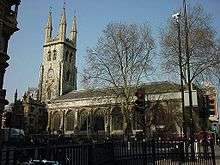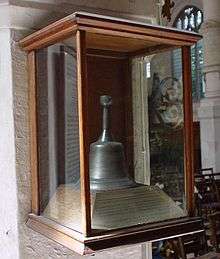St Sepulchre-without-Newgate
| St Sepulchre-without-Newgate | |
|---|---|
| Church of the Holy Sepulchre | |
 Photo of St. Sepulchre-without-Newgate | |
| Location |
Holborn Viaduct London EC1A 2DQ |
| Country | United Kingdom |
| Denomination | Church of England |
| History | |
| Founded | 12th century |
| Dedication | Edmund the Martyr |
| Architecture | |
| Status | Parish church |
| Functional status | Active |
| Heritage designation | Grade I listed building |
| Style | Gothic (tower)[1] |
| Years built | 15th century (rebuilt) |
| Completed | 1670 (reopened)[2] |
| Specifications | |
| Number of towers | 1 |
| Bells | 12 |
| Administration | |
| Diocese | London |
| Province | Canterbury |
| Clergy | |
| Priest in charge | David Ingall |
St Sepulchre-without-Newgate, also known as the Church of the Holy Sepulchre (Holborn), is an Anglican church in the City of London. It is located on Holborn Viaduct, almost opposite the Old Bailey. In medieval times it stood just outside ("without") the now-demolished old city wall, near the Newgate. It has been a living of St John's College, Oxford, since 1622 and is part of the area designated the "Newgate Street Conservation Area" (No.6) by the City of London Corporation.[3]
History
The original Saxon church on the site was dedicated to St Edmund the King and Martyr. In 1137 it was given to the Priory of St Bartholomew. During the Crusades in the 12th century the church was renamed St Edmund and the Holy Sepulchre, in reference to the Church of the Holy Sepulchre in Jerusalem, by soldiers who passed by the church on the way to the Holy Lands.[2] The name eventually became contracted to St Sepulchre.
The church is today the largest parish church in the City. It was completely rebuilt in the 15th century but was gutted by the Great Fire of London in 1666,[4] which left only the outer walls, the tower and the porch standing[5] -. Modified in the 18th century, the church underwent extensive restoration in 1878. It narrowly avoided destruction in the Second World War, although the 18th-century watch-house in its churchyard (erected to deter grave-robbers) was completely destroyed and had to be rebuilt.
The interior of the church is a wide, roomy space with a coffered ceiling[6] installed in 1834. The Vicars' old residence has recently been renovated into a modern living quarter.

During the reign of Mary I in 1555, St Sepulchre's vicar, John Rogers, was burned as a heretic.
The bell
St Sepulchre is named in the nursery rhyme Oranges and Lemons as the "bells of Old Bailey".[7] In 1605, London merchant tailor Mr. John Dowe paid the parish ₤50 to buy a handbell on the condition that it would be rung to mark the execution of a prisoner at the nearby gallows at Newgate.[8] This handbell, known as the Execution Bell, now resides in a glass case to the south of the nave. Between the 17th and 19th centuries, the clerk of St Sepulchre's was responsible for ringing a handbell outside the condemned man's cell in Newgate Prison the night before his execution and announcing the news by repeating the following "wholesome advice":[8][1]
"All you that in the condemned hold do lie,
Prepare you, for to-morrow you shall die;
Watch all, and pray, the hour is drawing near
That you before the Almighty must appear;
Examine well yourselves, in time repent,
That you may not to eternal flames be sent.
And when St. Sepulchre's bell to-morrow tolls,
The Lord above have mercy on your souls.
Past twelve o'clock!"
Given its proximity to both Newgate Prison and the Old Bailey, the bells in its tower, in addition to the usual functions of marking time, were rung to announce executions. On the day of the execution, the bells were tolled as the condemned were led to Tyburn.[1][9]
- The bell tower
 The Execution Bell
The Execution Bell
Musicians' church
The church has been the official musicians' church for many years and is associated with many famous musicians. Its north aisle (formerly a chapel dedicated to Stephen Harding) is dedicated as the Musicians' Chapel, with four windows commemorating John Ireland, the singer Dame Nellie Melba, Walter Carroll and the conductor Sir Henry Wood respectively.[10] Wood, who "at the age of fourteen, learned to play the organ" at this church and later became its organist, also has his ashes buried in this church.
Military link

The south aisle of the church holds the regimental chapel of the Royal Fusiliers (City of London Regiment) (merged to form the Royal Regiment of Fusiliers), and its gardens are a memorial garden to that regiment.[11] The west end of the north aisle has various memorials connected with the City of London Rifles (the 6th Battalion London Regiment). The church was designated a Grade I listed building on 4 January 1950.[12]
Notable people associated with the church
- Thomas Culpeper, buried here
- Sir Anthony St Leger and his first wife Eleanor, buried here.
- Thomas Gouge, ejected minister in 1662
- John Rogers, minister, Bible translator, and the first English Protestant martyr under Mary I of England
- Austin Osman Spare attended the church school, now a physiotherapy centre, behind the church in Snowhill Lane
- Peter Mullen, conservative commentator and former rector
- John Smith, governor of Virginia and associate of Pocahontas: buried 1631. Smith is commemorated by a handsome window designed by Francis Skeat and installed in 1968.[13]
- Sir Henry Wood, conductor
- Samuel Gurney erected the first drinking fountain for the Metropolitan Drinking Fountain and Cattle Trough Association on the railings of the church. It was restored to the original location in 1913 and remains there.
Organ
The north aisle is dominated by a splendid organ built by Renatus Harris in 1670.[14] The swell was added by John Byfield in c.1730. The organ was enlarged in 1817 by James Hancock and by John Gray in 1828 and 1835, and Gray and Davison in 1849, 1852 and 1855. It was rebuilt in 1932 by Harrison and Harrison. A specification of the organ can be found on the National Pipe Organ Register. It is not currently playable, and an electric organ is used when required for services.
Organists
- Francis Forcer 1676–1704
- Thomas Deane 1705–1712
- Benjamin Short 1712–1760
- William Selby and Samuel Jarvis 1760–1773
- Samuel Jarvis 1773–1784
- George Cooper 1784–1799
- George Cooper 1799–1843 (son of above)
- George Cooper 1843–1876 (son of above)
- James Loaring
- Edwin Matthew Lott
- Edgar Pettman
- Frank B. Fowle ca. 1921
See also
References
- 1 2 3 Piper, David; Jervis, Fionnuala. The Companion Guide to London. p. 350.
- 1 2 "NEWGATE: Conservation Area Character Summary" (PDF). Corporation of London. 1999.
- ↑ "Newgate Street Conservation Area [No. 6]". City of London Corporation.
- ↑ Latham, Robert, ed. (1985). Samuel Pepys - The Shorter Pepys. Harmondsworth: Penguin Books. p. 484. ISBN 0-14-009418-0.
- ↑ Cobb, G (1942). The Old Churches of London. London: Batsford.
- ↑ "London:the City Churches” Pevsner,N/Bradley,S New Haven, Yale, 1998 ISBN 0-300-09655-0
- ↑ "Our Community — Bells". stsepulchres.org.
- 1 2 St. Sepulchre's and its neighbourhood. Old and New London, Volume 2. Cassell, Petter & Galpin (courtesy of British History Online). 1878. pp. 447–491.
- ↑ "London's secret sights: 14 odd attractions you never knew were there". The Daily Telegraph.
- ↑ "The London Encyclopaedia" Hibbert,C;Weinreb,D;Keay,J: London, Pan Macmillan, 1983 (rev 1993,2008) ISBN 978-1-4050-4924-5
- ↑ "The Visitors Guide to the City of London Churches" Tucker,T: London, Friends of the City Churches, 2006 ISBN 0-9553945-0-3
- ↑ Historic England. "Details from image database (199516)". Images of England. accessed 23 January 2009
- ↑ "The John Smith Window". St. Sepulchre-without-Newgate. Retrieved 22 December 2010.
- ↑ Pearce,C.W. “Notes on Old City Churches: their organs, organists and musical associations” London, Winthrop Rogers Ltd 1909
External links
- St Sepulchre-without-Newgate church website
Coordinates: 51°31′0.07″N 0°6′8.47″W / 51.5166861°N 0.1023528°W